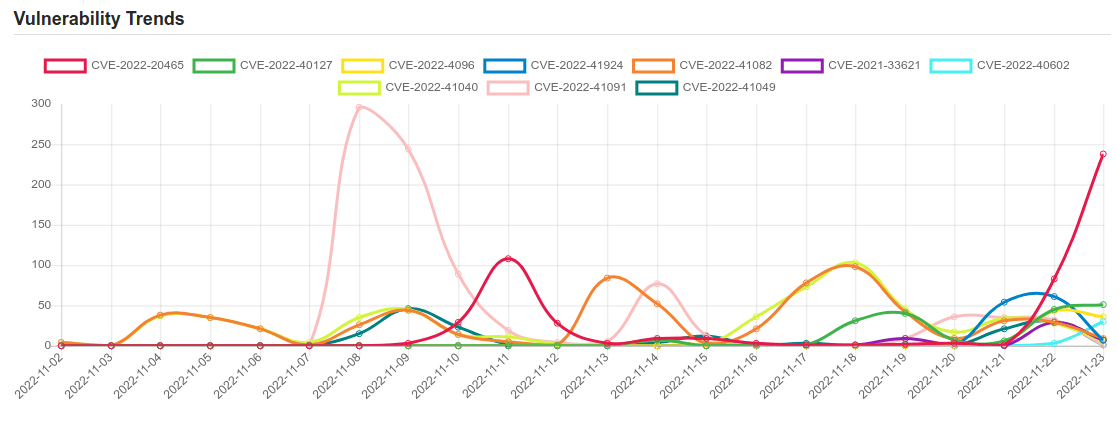Daily Vulnerability Trends: Thu Nov 24 2022

| CVE NAME | CVE Description |
| CVE-2022-41049 | Windows Mark of the Web Security Feature Bypass Vulnerability. This CVE ID is unique from CVE-2022-41091. |
| CVE-2022-37966 | Windows Kerberos RC4-HMAC Elevation of Privilege Vulnerability. |
| CVE-2020-8492 | Python 2.7 through 2.7.17, 3.5 through 3.5.9, 3.6 through 3.6.10, 3.7 through 3.7.6, and 3.8 through 3.8.1 allows an HTTP server to conduct Regular Expression Denial of Service (ReDoS) attacks against a client because of urllib.request.AbstractBasicAuthHandler catastrophic backtracking. |
| CVE-2022-43781 | There is a command injection vulnerability using environment variables in Bitbucket Server and Data Center. An attacker with permission to control their username can exploit this issue to execute arbitrary code on the system. This vulnerability can be unauthenticated if the Bitbucket Server and Data Center instance has enabled “Allow public signup”. |
| CVE-2022-33942 | Protection mechanism failure in the Intel(R) DCM software before version 5.0 may allow an unauthenticated user to potentially enable escalation of privilege via adjacent access. |
| CVE-2022-3910 | Use After Free vulnerability in Linux Kernel allows Privilege Escalation. An improper Update of Reference Count in io_uring leads to Use-After-Free and Local Privilege Escalation. When io_msg_ring was invoked with a fixed file, it called io_fput_file() which improperly decreased its reference count (leading to Use-After-Free and Local Privilege Escalation). Fixed files are permanently registered to the ring, and should not be put separately. We recommend upgrading past commit https://github.com/torvalds/linux/commit/fc7222c3a9f56271fba02aabbfbae999042f1679 https://github.com/torvalds/linux/commit/fc7222c3a9f56271fba02aabbfbae999042f1679 |
| CVE-2022-43707 | MyBB 1.8.31 has a Cross-site scripting (XSS) vulnerability in the visual MyCode editor (SCEditor) allows remote attackers to inject HTML via user input or stored data |
| CVE-2022-3602 | A buffer overrun can be triggered in X.509 certificate verification, specifically in name constraint checking. Note that this occurs after certificate chain signature verification and requires either a CA to have signed the malicious certificate or for the application to continue certificate verification despite failure to construct a path to a trusted issuer. An attacker can craft a malicious email address to overflow four attacker-controlled bytes on the stack. This buffer overflow could result in a crash (causing a denial of service) or potentially remote code execution. Many platforms implement stack overflow protections which would mitigate against the risk of remote code execution. The risk may be further mitigated based on stack layout for any given platform/compiler. Pre-announcements of CVE-2022-3602 described this issue as CRITICAL. Further analysis based on some of the mitigating factors described above have led this to be downgraded to HIGH. Users are still encouraged to upgrade to a new version as soon as possible. In a TLS client, this can be triggered by connecting to a malicious server. In a TLS server, this can be triggered if the server requests client authentication and a malicious client connects. Fixed in OpenSSL 3.0.7 (Affected 3.0.0,3.0.1,3.0.2,3.0.3,3.0.4,3.0.5,3.0.6). |
| CVE-2018-13379 | An Improper Limitation of a Pathname to a Restricted Directory (“Path Traversal”) in Fortinet FortiOS 6.0.0 to 6.0.4, 5.6.3 to 5.6.7 and 5.4.6 to 5.4.12 and FortiProxy 2.0.0, 1.2.0 to 1.2.8, 1.1.0 to 1.1.6, 1.0.0 to 1.0.7 under SSL VPN web portal allows an unauthenticated attacker to download system files via special crafted HTTP resource requests. |
| CVE-2021-41773 | A flaw was found in a change made to path normalization in Apache HTTP Server 2.4.49. An attacker could use a path traversal attack to map URLs to files outside the directories configured by Alias-like directives. If files outside of these directories are not protected by the usual default configuration “require all denied”, these requests can succeed. If CGI scripts are also enabled for these aliased pathes, this could allow for remote code execution. This issue is known to be exploited in the wild. This issue only affects Apache 2.4.49 and not earlier versions. The fix in Apache HTTP Server 2.4.50 was found to be incomplete, see CVE-2021-42013. |
| CVE-2020-11110 | Grafana through 6.7.1 allows stored XSS due to insufficient input protection in the originalUrl field, which allows an attacker to inject JavaScript code that will be executed after clicking on Open Original Dashboard after visiting the snapshot. |
| CVE-2022-20465 | In dismiss and related functions of KeyguardHostViewController.java and related files, there is a possible lockscreen bypass due to a logic error in the code. This could lead to local escalation of privilege with no additional execution privileges needed. User interaction is not needed for exploitation.Product: AndroidVersions: Android-10 Android-11 Android-12 Android-12L Android-13Android ID: A-218500036 |
| CVE-2022-40127 | A vulnerability in Example Dags of Apache Airflow allows an attacker with UI access who can trigger DAGs, to execute arbitrary commands via manually provided run_id parameter. This issue affects Apache Airflow Apache Airflow versions prior to 2.4.0. |
| CVE-2022-4096 | Server-Side Request Forgery (SSRF) in GitHub repository appsmithorg/appsmith prior to 1.8.2. |
| CVE-2022-41924 | A vulnerability identified in the Tailscale Windows client allows a malicious website to reconfigure the Tailscale daemon `tailscaled`, which can then be used to remotely execute code. In the Tailscale Windows client, the local API was bound to a local TCP socket, and communicated with the Windows client GUI in cleartext with no Host header verification. This allowed an attacker-controlled website visited by the node to rebind DNS to an attacker-controlled DNS server, and then make local API requests in the client, including changing the coordination server to an attacker-controlled coordination server. An attacker-controlled coordination server can send malicious URL responses to the client, including pushing executables or installing an SMB share. These allow the attacker to remotely execute code on the node. All Windows clients prior to version v.1.32.3 are affected. If you are running Tailscale on Windows, upgrade to v1.32.3 or later to remediate the issue. |
| CVE-2022-41082 | Microsoft Exchange Server Remote Code Execution Vulnerability. |
| CVE-2021-33621 | The cgi gem before 0.1.0.2, 0.2.x before 0.2.2, and 0.3.x before 0.3.5 for Ruby allows HTTP response splitting. This is relevant to applications that use untrusted user input either to generate an HTTP response or to create a CGI::Cookie object. |
| CVE-2022-40602 | A flaw in the Zyxel LTE3301-M209 firmware verisons prior to V1.00(ABLG.6)C0 could allow a remote attacker to access the device using an improper pre-configured password if the remote administration feature has been enabled by an authenticated administrator. |
| CVE-2022-41040 | Microsoft Exchange Server Elevation of Privilege Vulnerability. |
| CVE-2022-41091 | Windows Mark of the Web Security Feature Bypass Vulnerability. This CVE ID is unique from CVE-2022-41049. |
A considerable amount of time and effort goes into maintaining this website, creating backend automation and creating new features and content for you to make actionable intelligence decisions. Everyone that supports the site helps enable new functionality.
If you like the site, please support us on Patreon using the button below

To keep up to date follow us on the below channels.




![[RALORD] - Ransomware Victim: agromate company 6 image](https://www.redpacketsecurity.com/wp-content/uploads/2024/09/image-300x300.png)
